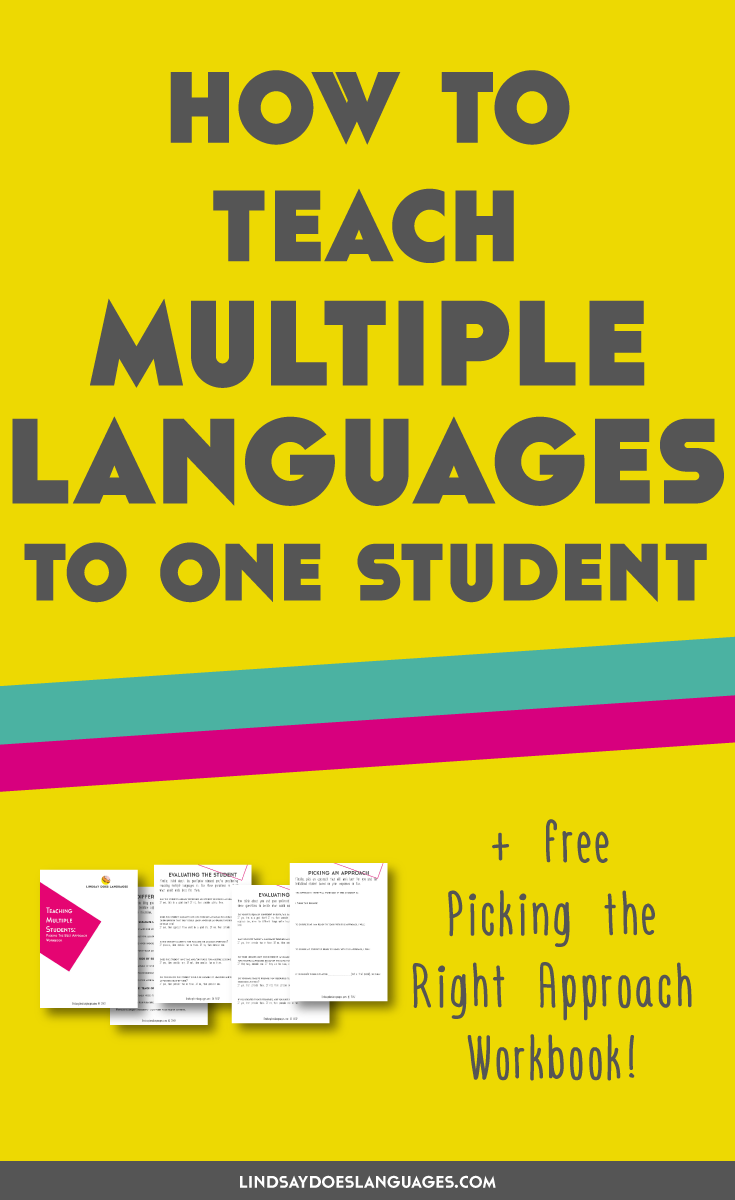October 4th, 2017
How to Teach Multiple Languages to One Student
From time to time, you’ll find yourself inspiring a passion for languages in some students that leads to them wanting to learn more. But how do you teach multiple languages to one student?

Once you’ve decided to teach languages online and you speak more than two other languages, eventually the question will come up about teaching multiple languages.
If we stick with the idea of teaching two languages at once, there are three main approaches to this that we’ll look at in this post.
The first approach is what I have previously used, in part due to both the student needing one language for school and the other for pleasure, and the student wanting to have separate lessons.
In another case, I had a student studying both French and Spanish for A levels. We tended to have one French and one Spanish lesson per week.
However, that was more open and if they needed to focus on something French, for example, because they had a French test/coursework/something else important due, but I arrived for a Spanish lesson, then it was important to be flexible enough for me to switch on the spot.
At other times, there’d be schoolwork due in both languages, so we’d do 30 minutes in one language and 30 minutes in the other in the same lesson.
When to do one or the other?
Consider your own language abilities.
Chances are if you’re offering to teach, than your ability in both is sufficient and doesn’t need to be questioned, but it could be that one language feels stronger to you than the other. Pick the approach that works best for you considering your own language abilities.
Consider the student’s needs.
If you’re teaching one language for exam/school/university/work and the other for pleasure, than teaching them separately is likely to be the best approach to avoid mixing them up as best as possible.
Consider the student’s time.
Do they have time (and funds) to have multiple lessons per week? If not and they’re really keen to study both, then approach two or three is best.
Consider the student’s wants.
What approach does the student want to take? If they’re super language keen and have one language stronger than the other, then maybe they’re up for trying approach 3 and learning one language through the other. Deciding on one approach doesn’t mean setting it in stone – you can always change the approach you use at a later date.
Approach 1: Separate Lessons
The first approach is teaching multiple languages in separate lessons.
This is the approach I mostly took when teaching multiple languages and worked best if we had one lesson in each language weekly.
Here’s a few things to consider…
Consider different places for lessons
By teaching multiple languages in separate lessons, you’re keeping them in their own space for students, which works well if students struggle with confusing languages. However, this does mean multiple lessons per week.
With that in mind, it could be worth considering teaching each language in a different place – perhaps French in the living room and Spanish in the dining room.
If you’re online of course, this poses a slightly different challenge because you have to ensure they remember to move if they think it is going to help them, and you could even change where you sit for each lesson to to mix up your background.
Consider bilingual classroom research.
This approach is the easiest one to do your research for, albeit lots of research in classrooms and not online settings.
There’s plenty out there to dig your teeth into about teaching one language through another, most commonly called ‘bilingual immersion’ when refering to the classroom.
And you can draw from this research when you’re planning your approach.
Division in some form is often seen as key here. Whether it’s division by time, context or staff, as this article suggests, splitting the languages is seen as useful.
The previous point about considering different places fits with this idea too.
Do encourage at least one lessons in each language per week
Alternating between lessons week by week or on an even less frequent basis makes it tough for students to learn and remember anything worthwhile, especially if they’re the kind of student who isn’t prone to studying in between the lessons you have together.
How frequently you have lessons depends on how many lessons the student wants or can afford. But ideally, you would have at least one lesson in each language per week. This helps to ensure regular contact with both languages and avoids one growing quicker than the other as best as possible.
Do encourage cross-over understanding
Despite teaching the languages separately, do encourage cross-over understanding between them.
Let’s take the example that both Spanish and French use male and female gender, but some words are masculine in one language that are feminine in the other.
Pointing these words out in a Spanish lesson and saying, “Can you remember the gender of this in French?”, for example, helps to reinforce knowledge and encourages connections between the two languages that can actually help more than you might expect.
It’s also beneficial when learning new vocabulary. For example, seeing the Spanish word ‘biblioteca’ for the first time and already knowing the French word ‘bibliotheque’ means ‘library’, could just help students guess the meanings of new words, speeding up the process and forming stronger connections.
Teach different things in each language at same time
Providing the student has at least a base knowledge in one language and you’re not having to teach both languages from scratch, it’s very beneficial in my experience to teach different things in both languages at the same time.
If you’re learning about food and restaurant scenarios in your French lesson on Monday, don’t plan exactly the same thing for Spanish on Wednesday.
Instead, teach different things to help avoid confusion.

Approach 2: side by side in the same lesson
The second approach is to teach both languages at the same time in the same lesson.
For example, think about this as adding French to your existing Spanish resources instead of recreating them in French.
However, this may be quite difficult for some students, so here are a few things to consider about this approach.
Ensure student is capable of studying both languages side-by-side
When students only have the time and/or funds for one lesson per week maximum but they want to learn multiple languages, consider teaching them side-by-side.
Sounds kinda crazy at first, huh?
I remember a couple of years back now at the Polyglot Gathering, I went to a talk from Elisa Polese about how she teaches 10 languages at the same time. Yes. Ten.
It completely blew my mind, both in terms of how it could be done from a learning perspective and a teaching one.
So teaching multiple languages at the same time, with the same content, alongside one another is possible. But it may not be possible for every student.
I can think of plenty of students I’ve taught in the past who would shy away from this approach and really not do well with it, so it’s important that you discuss how this approach works (as it is with any approach) and ensure they understand, accept and are capable of what it involves.
Encourage cross-over understanding
Again, cross-over understanding is very clearly important here. You’re quite literally putting the words side-by-side in front of them. Students will be able to clearly see connections and differences between languages.
Cultural differences even more important than usual
Language and culture are so intertwined that it’s near impossible to teach language without teaching culture, even if you’re not doing so intentionally.
However, when teaching languages side-by-side, the cultural differences are even more important because this will help students to differentiate between languages through the cultural differences.

Approach 3: teach one through another
If one language is stronger than the other, this may well be the best approach.
Think about this before you start though…
One language generally needs to be higher.
If you have a student who already has a relatively high level in a language that they’d like to keep improving, as well as a new language they’d like to learn, then teaching one language through another can be a great way to incorporate multiple languages into one lesson.
However, students do need one language that is already sufficient enough to learn via. Consider if it’s worth testing this beforehand, either formally or informally, so you are aware of their current level in the language you’d be teaching in.
It’s not too much of a problem to be translating the odd word here and there, but the last thing you want (or probably they want) is to be stopping every few seconds to translate the instructions and explanations.
That said, don’t be afraid to go into the third language from time to time, aka the student’s native language, to explain things when needed, especially when teaching children. Research has found that children’s mother tongue is important to their overall development.
Best when learning for pleasure.
This approach works best when students are learning for pleasure. That way, the pressure is off to constantly be striving for school grades or levels for exams.
It also allows the class to flow more freely, which helps as you can adjust your topics and teaching to fit with their abilities in the language being used to teach and where they’re currently at with the language being taught.
Preparing unique resources – make sure your time is covered.
One big difference here is that your resources are likely to be different from your standard set.
This is fine if you teach multiple students with the same teaching and being taught language pairs, however, otherwise, you have to ensure that you’re time is covered for creating any new resources you’ll need for these lessons.
Creating resources in Google Drive is a great way to easily edit and copy things for various languages. It’s also a super easy way to share your resources with students when you need to too.
Over to you!
I hope this post has given you an idea of where to start and got you thinking about which approach would suit your current students best.
Offering to teach multiple languages can be a great way to separate yourself from other online language teachers so remember to include it in your promotion and on your website.







